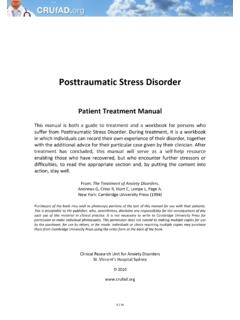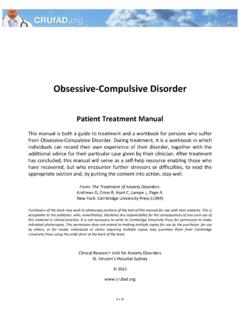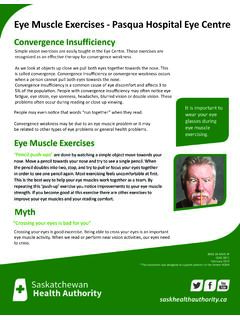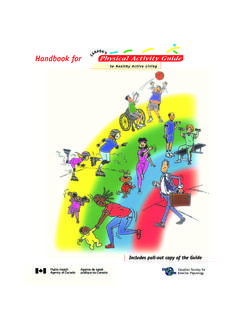Transcription of Anxiety and Panic Disorder - CRUfAD
1 1 | 92 Anxiety and Panic Disorder Patient Treatment Manual This manual is both a guide to treatment and a workbook for persons who suffer from Anxiety and Panic Disorder . During treatment, it is a workbook in which individuals can record their own experience of their Disorder , together with the additional advice for their particular case given by their clinician. After treatment has concluded, this manual will serve as a self help resource enabling those who have recovered, but who encounter further stressors or difficulties, to read the appropriate section and, by putting the content into action, stay well. From: The Treatment of Anxiety disorders .
2 Andrews G, Crino R, Hunt C, Lampe L, Page A. New York: Cambridge University Press (1994) Purchasers of the book may wish to photocopy portions of the text of this manual for use with their patients. This is acceptable to the publisher, who, nevertheless, disclaims any responsibility for the consequences of any such use of this material in clinical practice. It is not necessary to write to Cambridge University Press for permission to make individual photocopies. This permission does not extend to making multiple copies for use by the purchaser, for use by others, or for resale. Individuals or clinics requiring multiple copies may purchase them from Cambridge University Press using the order form at the back of the book.
3 Clinical Research Unit for Anxiety disorders St. Vincent s Hospital Sydney 2010 iINDEX1. THE NATURE OF Anxiety AND Panic Panic Attacks, Panic Disorder & Rationale of the Anxiety and the fight or flight The Effect of Anxiety and Types of Common myths about Anxiety CONTROL OF Recognising Slow-Breathing Daily Record of Breathing RELAXATION What is relaxation training?..152. Importance of Relaxation Components of Relaxation Recognising Progressive Muscle Getting the most out of progressive muscle Isometric Relaxation Difficulties with GRADED Development of Situational More about Overcoming Planning your Implementing your Practising the Exercises in Planning Achieving your personal COGNITIVE RESTRUCTURING Misinterpretation and Step 1: Identifying Anxiety provoking Step 2: Challenging Anxiety provoking Step 3.
4 Generating alternative COGNITIVE RESTRUCTURING PRODUCING Panic Panic Sensations Constructing a hierarchy of Panic sensation Scheduling the Panic sensations FOR THE BREAK AND Panic SENSATIONS SOCIAL CONCERNS IN Panic What factors influence Defining assertion What is faulty assertion?..815. Protective skills ..836. Decision to KEEPING PROGRESS treatment of Anxiety disorders in the Clinical Research Unit for Anxiety disorders began in1978 when the Agoraphobia Treatment Progran was set up at Prince Henry Hospital. Since then,various programs have been developed for other Anxiety disorders , especially Social Phobia, PanicDisorder, Generalised Anxiety Disorder , Obsessive-Compulsive Disorder , and Specific people have contributed to the writing of the treatment manuals for the various are: Gavin Andrews, Rocco Crino, John Franklin, Caroline Hunt, Stephen McMahon,Richard Mattick, Carmen Moran, Andrew Page and Susan Tanner.
5 In addition, various books havebeen useful in obtaining ideas regarding treatment; these are cited at the end of this would like to acknowledge the work of the Centre for Stress and Anxiety disorders , Universityof Albany, State University of New York, and the University of Oxford, Department of useful material from the Anxiety and Panic program devised by David Barlow and MichelleCraske has been used in the development of the present treatment present version of this manual was edited by John Lam-Po-Tang and Stephanie Rosser, andrepresents the state of treatment in 1 THE NATURE OF Anxiety AND Panic DISORDER1.
6 Panic Attacks, Panic Disorder & AgoraphobiaA Panic Attack is a sudden spell or attack when you felt frightened, anxious or very uneasy in asituation when most people would not feel afraid. During one of these attacks the followingsymptoms may occur:shortness of breathtrembling or shakingpounding hearthot or cold flushesdizzy or light headed things around you feel unrealtingling fingers or feetdry mouthtightness or pain in the chestnausea or butterfliesa choking or smothering feeling"jelly legs"feeling faintblurred visionsweatingmuscle tensionfeeling you can t get your thoughts together or speakfear you might die, lose control or act in a crazy wayPanic Disorder is the name given to the condition in which people have unexpected Panic attacks,worry about what Panic attacks might do or mean, and change their behaviour as a result of havingpanic attacks.
7 Individuals with Panic Disorder will have experienced a number of these symptomsduring a Panic attack. Different people will find different symptoms more frightening or unpleasantthan the Panic becomes severe most people try to get out of the particular situation, hoping thepanic will stop. Alternatively, they get help because of fears they might collapse, have a heartattack, or go crazy. Occasionally, some people want to be alone so that they don't embarrassthemselves in some way. When individuals start associating Panic attacks with certain situations,they often try to minimise the Panic attacks by avoiding the same or similar situations.
8 Forexample, some people who have their first Panic attack on a train may start to avoid trains andbuses in the future. When this avoidance is widespread and severe, the condition is that are avoided by people with agoraphobia (or endured with Anxiety or discomfort) canusually be understood as situations from which escape might be difficult (physically or socially) orin which it might be difficult to obtain help if a Panic attack occurs. An underground train is anexample of a situation from which it is physically difficult to escape, whereas a dinner party is anexample of a situation from which leaving might be socially awkward.
9 Being alone at home oralternatively, a long way from home, are examples of situations in which it might be difficult toobtain help. There are, of course, situations that combine elements of these: being on a peak-hourtrain could be seen to involve difficulty escaping as well as difficulty obtaining first few times that someone experiences a Panic are usually very frightening, because this is anew experience that seems strange and abnormal. However, after many such experiences mostpeople know deep down that they are unlikely to either collapse, die, or go crazy. At least theyhaven't up till now. However, many fear that next time may be different - that the next Panic maybe the worst.
10 Some people manage to resign themselves to the experience of Panic , even thoughthey don't like the experience. Panics rarely come truly out of the blue. Even the first attack usuallyoccurs at a time when the individual is under emotional pressure, or unwell ( , recovering fromthe flu), or when they were tired and exhausted and beginning to feel at the end of their attacks are very uncommon when someone is truly safe and have already talked about avoidance of actual situations, but there are also other types ofavoidance which, although more subtle, are nevertheless connected to Panic you avoid medication of any kind even if your doctor prescribes it?






